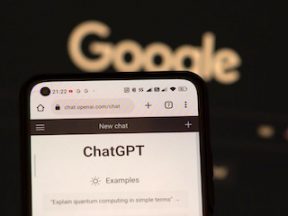I did not use artificial intelligence to write this article, but perhaps I should have. Generative AI is already upending content marketing and journalism. The change is good news so long as the content provides value to people.
Content marketing is among the most effective organic tools to attract, engage, and retain consumers. But writing article after article or producing video after video can feel like a neverending grind, like Sisyphus in Greek mythology pushing a rock up the hill.

An AI-generated image from Midjourney of Sisyphus pushing a boulder.
Generative AI for Content Marketing
Generative AI from large language models reduces the time to develop content ideas, create the material, optimize for organic search traffic, and then update it for new information.
By some estimates, generative AI improves marketing productivity by 5 to 15%.
Others have suggested that generative AI could also improve consistency. For example, AI could match a brand’s written style and tone of voice across many articles and social media posts more consistently than humans.
Some observers, including the authors of a recent McKinsey & Company paper, “The Economic Potential of Generative AI,” believe the technology will help marketers gather data from disparate sources such as databases, social media posts, and even images and synthesize it into usable market intelligence, informing content marketers what they should write, to whom they should write it, and in which languages.
The temptation for writers is to let generative AI do all the work.
For example, I recently used generative AI to write a 1,782-word article for a personal finance site. The combination of GrammarlyGO, ChatGPT, and Midjourney produced the first draft of the content and its associated image in just eight minutes.
It was tempting to paste the 30 or so paragraphs into the site’s editor and click publish.
Average Content
Permitting AI writing tools to generate articles willy-nilly will almost certainly produce a lot of average or even mediocre content.
Large language models guess what word should come next in a sentence.
To write an article about vacation travel in France, AI considers thousands of sources about travel in France and chooses the most likely words. It begins by writing the first paragraph in an average way, continuing with each word choice and each line to produce something similar to everything else written about French travel.
A better solution is to combine generative AI’s productivity boosters and human guidance.
Human Guidance
In the content marketing context, human guidance uses generative AI as an assistant, not a full-on writer.
Here’s an example:
- Strategy. Understand what content marketing should do for your business before using generative AI. Content marketing aimed at customer acquisition is often different than for customer retention. Have a strategy before instructing AI to compose anything.
- Ideas. With a clear content goal, marketers can use AI to generate article ideas and even outlines. A human editor may then select topics and modify outlines.
- Drafts. Generative AI can draft the content sections one by one, following the outline.
- Editing and enhancement. A human editor should read each section, update it with appropriate examples, and give it back to the AI to improve the next section of the outline.
- Optimization. The final AI pass through the content could focus on optimizing for search engines or on-site conversions.
At every step, a human marketer guides the content creation process. The result is quickly-produced content with a human touch for excellence.
Application
Marketing teams have applied generative AI overseen by humans to the Hero, Hub, Help model.
In this framework, a marketer has three general content types. “Hero” content is top-notch, likely to go viral, and produced relatively infrequently. “Hub” content is foundational and gives an audience a reason to return. “Help” content seeks to address specific needs.
Generative AI can focus (but not control) on the hub and help types, while humans develop hero content.




